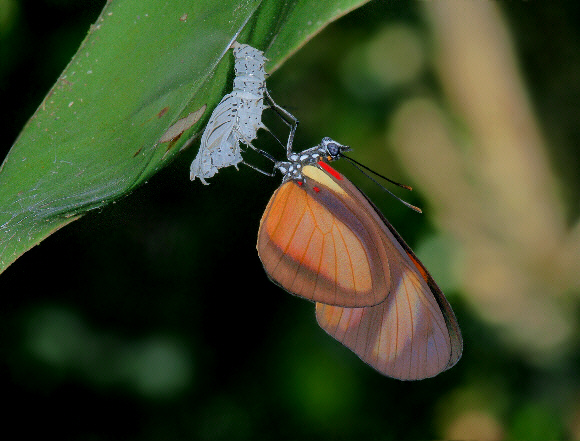 Eueides lybia, newly emerged from chrysalis, Rio Madre de Dios, Peru – Adrian Hoskins
Eueides lybia, newly emerged from chrysalis, Rio Madre de Dios, Peru – Adrian Hoskins
Introduction
The tribe Heliconiini, colloquially known as Longwings, includes 71 species, all confined exclusively to the neotropics. The butterflies are characterised by possessing distinctively patterned elongated forewings and a delicate fluttering flight. The Heliconiini includes the genus Heliconius ( 39 species ), together with the smaller genera Dryas, Agraulis, Dryadula, Eueides, Neruda, Laparus, Philaethria, Dione and Podotricha.
The 12 Eueides species are similar to other Heliconiines but smaller in size. Some such as isabella are mimics of tiger-complex Ithomiines, while others including aliphera and lineata are very similar to Dryas and Dione in appearance. A few such as vibilia closely resemble Actinote species. Eueides heliconioides falls into yet another group which strongly resemble Laparus doris. To further confuse matters the butterfly was known by the name Heliconius eanes until the 1970’s!
A major characteristic which helps to distinguish Eueides from similar taxa is the shape and length of the antennae – in Eueides these are never more than half the length of the costa; in Actinote they are about the same length but are very strongly clubbed. In the tiger-complex Ithomiines they are long, tapered, cream in colour and dropping. In Heliconius and Laparus they are about two-thirds the length of the costa, and erect.
Eueides lybia is found from Nicaragua to Bolivia.
Habitats
This canopy dwelling species occurs at altitudes between 0-1400m on both sides of the Andes.
Lifecycle
The eggs are laid singly on Passiflora vines. The caterpillars feed solitarily and are black except for white patches on the thorax and anal segment. They have long, bristled spines along the back and sides. There is a broad yellowish stripe along the sides. The head is black and shiny with a pair of long recurved horns. The pupa is white, marked with brown streaks on the wing cases and blackish dots on the abdomen and thorax. It is suspended by the cremaster from a leaf.
Adult behaviour
Both sexes spend most of their time high in the canopy and are rarely seen on the ground, but will sometimes visit Lantana or Psiguria flowers for nectar. Females can sometimes be seen flying along forest edges in dappled sunlight in search of oviposition sites. The emerging adult illustrated above was found at a height of about 2m in the vicinity of a small stream in primary forest. The butterflies roost gregariously, as do many other Heliconiines.
